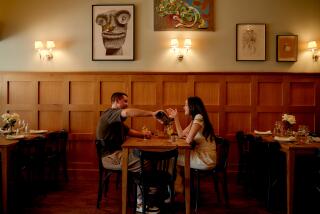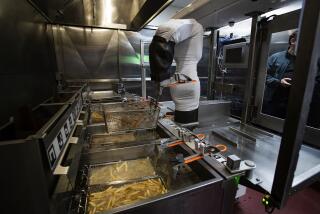Publicâs Thirst Keeps Brewery Chugging Along
VAN NUYS â Judy Noonan and Janet Summerour work in a madcap realm of exploding glass, screaming machinery and the incessant clink-clink-clink of millions of empty bottles scuttling along a conveyor belt that has no end.
A real-life Laverne and Shirley, they report each day to the worldâs third-largest brewery--the Anheuser-Busch plant, a skulking cluster of factory buildings along the San Diego Freeway, that belches steady wisps of dull-gray steam from its rooftop chimneys.
On good days, the duo can bottle enough beer to inebriate a small country. And then there are the shifts from brewery hell--the scenes of embarrassing goof-ups and conveyor-line catastrophes.
Like the sudden bottle blast that left a shard of glass jutting from Noonanâs protective goggles like an errant arrow. Or when Summerour mistakenly glued the labels upside-down onto more than 800 cases of Budweiser.
Worse yet, brewer Mark Roberts has seen snafus that have caused steaming billows of 212-degree foam to ooze from the big cooker kettles, spreading across the brew house floor like The Blob.
But for 1,500 employees laboring in this frenetic industrial city, itâs all in a dayâs work helping to feed Americaâs insatiable appetite for its favorite alcoholic beverage--the heady, thick-bodied brew thatâs as old as the Egyptians.
Last year, Americans drank 5.8 billion gallons of beer, spending more than $52 billion, according to the Washington-based Beer Institute, a trade association. Thatâs 41 six packs--or 1 1/2 kegs--for every man, woman and child in America.
Moreover, beer makes up 80% of all alcoholic beverages consumed by Americans, followed by wine at 14% and distilled spirits at 6%. Aside from water, it ranks fourth in beverages that Americans crave--behind soft drinks, coffee and milk.
Beer-making has been big business in Los Angeles for generations. Just a decade ago, Southern California produced more beer than anywhere else in America, including Milwaukee or St. Louis.
That tradition, however, has since gone a bit flat.
Over the years, local factories making beers such as Lucky Lager, Brew 102, Stroh and Schlitz beers have closed their doors--along with some newfangled micro-breweries from downtown to Pasadena.
Now just two giant contenders remain--the local Anheuser-Busch factory and the Miller Co. brewery in Irwindale--where heavily unionized workers like Judy Noonan and Janet Summerour labor around the clock to sate a thirsty public.
Each day, the Anheuser-Busch brewery produces 8.4 million cans and 3.6 million bottles of beer, not to mention countless kegs and half-kegs--six days a week. The facility, which also exports to beer-drinkers from Central America to the Far East, ranks in size only behind the Coors facility in Golden, Colo., and the Anheuser-Busch home office in St. Louis.
Opened in 1954, Anheuser-Buschâs 90-acre Van Nuys facility once included a signature theme park, Busch Gardens, complete with rides and performing macaws. In 1979, the demand for beer moved the company to pave over the gardens for more production space.
Today, the plant produces some 12 million barrels daily--or 174.4 million cases. Each day, that fills at least two dozen rail cars and 325 tractor-trailers.
Itâs a self-sufficient city that never sleeps, engaging in the painstaking task of mixing the oatmeal-smelling hops and yeast with tons of barley, corn and rice to make more than half a dozen varieties of brew.
Inside the bowels of the place, humongous cookers and kettles perform a lengthy brewing process that involves turning whole grains to liquid, adding hops and yeast before aging the mix in cavernous cellars holding skyscraper-like tanks and stainless-steel vats.
Some five weeks after the beer-making process began, the end comes in a stadium-like, 18-acre warehouse where the finished product is canned, bottled and kegged in an atmosphere of controlled chaos.
Along with goggles, workers wear earplugs to shut out the drone of the huge packing machines, where blasts of air push the empty cans along the assembly line amid the crazy, nonstop rattle of the bottles. The din forces workers to communicate in sign language like students at a school for the deaf.
Supervisors scurry about on rickshaw-like bicycles and motorized scooters, pausing at vast intersections of machinery and stored cases--confluences with circular ceiling mirrors to warn of oncoming traffic.
In the middle of this industrial jungle, chemists in white lab coats dissect the finished product--using test tubes and special machines to examine color, flavor and alcohol content.
But no test or safety device can mask the smell of the place--the overwhelming sour aroma of spilled beer that permeates the bottling warehouse like the morning after a Saturday night frat house party.
Still, on hot days, even workers who donât drink beer are tempted by the brewâs allure. âYou start sweating in that place and you look down at all that beer going by and you think, âGosh, that looks good.â And I donât even drink the stuff,â Noonan says.
With their bubbling brew kettles and teeming production floors, both breweries in the region embody the spirit of the blue-collar, beer-drinking way of life.
The Van Nuys factory appeared in the opening credits of the old âLaverne and Shirleyâ television show, the story of two Milwaukee brewery pals.
And then there was the episode of âCheersâ where Norm--a bar-dwelling, beer-swilling, out-of-work accountant--wraps his arms around one of its towering storage tanks, expressing the sentiments of a beer-drinking generation:
âIâm in the brewery! Iâve finally reached heaven--my goal in life!â
*
With the exaggerated flair of a wine connoisseur, Van Nuys brew master Bob Mueller stands in the tasting room--the breweryâs spiritual epicenter--pouring a beer as slowly as a glass of molasses.
He holds the product to the sunlight, sniffing its foamy head, swirling the bottom of the glass. Then he takes a sip.
Unlike winemakers, part of this taste process is to swallow, to savor what is known as the beerâs âfull taste profile.â
âLook at that head!â Mueller crows, his waistline offering testimony to his craft. âIt gives a glass of beer such a picturesque appearance. When you see a beer without a head, what does it remind you of? To me, it looks like ginger ale. And this certainly is no ginger ale.â
At 3 p.m. each day, Mueller samples his beer, not just the finished product but also specimens taken from some dozen stages along the production line--from the filtered water to murky bottles of nonalcoholic fluid known as wort, so sweet that some workers pour it over pancakes.
Trailed by his managers, Mueller walks down a row of 20 bottles lined up like soldiers for a spot inspection. He also tastes the hops, the grains of corn and barley. What does not meet his standards is taken away, back to the beer-brewing drawing board.
As the factoryâs brew master, he is the general of this labyrinth. Part scientist, part artist, heâs a beer-lover with strong opinions about the current political climate he says lumps together drugs and alcohol as equals:
âIt irritates me, the way they throw the words drugs and alcohol around like they were the same thing. Weâre a legitimate business that has been part of this country since its inception. Our forefathers made and drank beer.
âItâs just hard to take when they compare us in the same breath with drugs. Drugs are illegal.â
In recent years, beer manufacturers have taken steps to control consumption within their industry--reversing a time-honored tradition among brewery workers that provided free beer during lunch and breaks.
Last call at the local Anheuser-Busch plant came on May 1, 1986, when free on-the-job suds were banned, replaced by two free monthly cases given to each employee for home consumption.
Employees say the beer ban was adopted after Mothers Against Drunk Driving pressured manufacturers following a 1982 incident in which a Van Nuys brewery worker, finishing his shift after a workday of beer-drinking, struck and killed a 16-year-old pedestrian.
Concerns over alcohol, Mueller says, have added to lukewarm industry sales over the last three years. But like undertakers, beer manufacturers know that their craft will always be in demand.
So, for now, Mueller continues to brew, test, sample and sell.
And each day in the taste room, after consuming several glasses of his product, he undergoes a test mandated by Anheuser-Busch policy:
He blows into a company Breathalyzer.
*
In their worst dreams, Judy Noonan and Janet Summerour become Lucy and Ethel--a slapstick pair of overwhelmed candy factory workers unable to keep pace with the endless conveyor line of chocolate.
âEven in your sleep, you hear buzzers going off and you want to go fix the problem on the assembly line,â Noonan says. âYou canât help yourself.â
Both are bottlers in the breweryâs packaging section, a world where man minds machine. Everywhere, mechanical arms reach here and there, plucking empty bottles--24 at a time--from their cases like the device that sets up bowling pins.
Noonan works Can Line 61, one of the plantâs four canning and five bottling lines, where she oversees the armies of empty cans that hurtle down a conveyor line to a wagon wheel-like machine that fills 130 cans at once.
Then the speeding missiles are capped with aluminum lids by a second machine and ushered off to a pasteurizer, where they are heated and then cooled to kill bacteria.
Every few minutes, the 44-year-old Noonan must feed new lids into the insatiable machine--sliding tops from cylindrical paper sleeves 372 at a time. It is like loading bullets into a noisy machine gun that never stops firing.
Meanwhile, cans whiz past on the conveyor at 1,800 a minute, or 30 every second. The line runs 24 hours a day, six days a week. Each eight-hour shift, Noonan supervises the filling and packaging of 24,000 cases of beer.
With a flick of a wrist, she plucks a can from the passing blur of aluminum to check for dents or labeling goofs. A wrong move can send cans flying.
Quick! Then itâs back to feed the lid machine. All the while, she watches out for the punctured cans that spray her with foamy beer, or the splashing oil from broken machines.
And so it goes on Line 61.
âAs the technology improves, the cans move faster and faster,â she says. âEven though, they want the same quality. If everything doesnât come out just right, shift after shift, it reflects on me.â
*
On the seventh day, the brewery rests.
Sunday is the one time when the huge packaging plant is silenced, closed for its weekly scouring.
Workers welcome such housecleanings, a break from the grueling day-to-day battle to get the beer out.
And when work is through, they drink nothing but their own product--especially when out on the town. If a bar or restaurant doesnât serve their label, theyâll make a point to ask why.
Sometimes, though, Noonan needs a great escape.
âEverywhere I go, I run into the Budweiser image. On delivery trucks. Billboards. Baseball caps. Youâre glad, because that means job security. But sometimes you just want to get away.
âIf just for a while, you want to get away from the world of beer.â
More to Read
Eat your way across L.A.
Get our weekly Tasting Notes newsletter for reviews, news and more.
You may occasionally receive promotional content from the Los Angeles Times.











